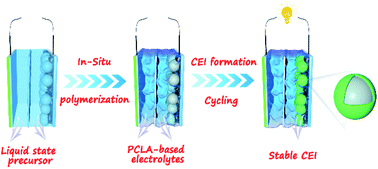In situ prepared “polymer-in-salt” electrolytes enabling high-voltage lithium metal batteries†
Abstract
Polymer electrolytes (PEs) are promising for constructing solid-state batteries with high energy density due to the great flexibility and high processability. However, it is difficult to construct such a system which is able to overcome the poor electrode/electrolyte interface contact, the growth of lithium dendrites and severe decomposition against a high-voltage cathode. Herein, a “polymer-in-salt” electrolyte (PISE) is in situ prepared to promote lithium ion transport, stabilize the lithium anode and improve the compatibility between PEs and the high-voltage cathode. With the high content of lithium salt (54 wt%) in the PISE, the lithium ion transference number is 0.6 at room temperature, and the Li/PISE/Li symmetric cells show a stable polarization voltage over 1000 h. What's more, the assembled NCM622/PISE/Li batteries display impressive high-voltage cyclability with 92.5% capacity retention over 160 cycles. Additionally, the NCM811/PISE/Li batteries also exhibit remarkable cycling stability at room temperature. This work provides the possibility of designing high-voltage solid-state lithium metal batteries by in situ polymerization.



 Please wait while we load your content...
Please wait while we load your content...